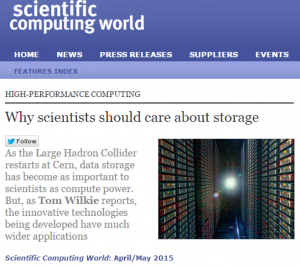 In a recently published article, “Why scientists should care about storage”, editor of Scientific Computing World, Tom Wilkie, offers a comprehensive and investigative perspective on the reasons data storage now rivals compute power in the eyes of the scientists responsible for the large Hadron Collider at CERN.
In a recently published article, “Why scientists should care about storage”, editor of Scientific Computing World, Tom Wilkie, offers a comprehensive and investigative perspective on the reasons data storage now rivals compute power in the eyes of the scientists responsible for the large Hadron Collider at CERN.
As part of his research Wilkie spoke Seagate, principal technologist, Jim Hughes. Hughes offered a perspective on both the technical aspects of Seagate collaboration with CERN Openlab, in order to develop its Kinetic Storage Platform, as well as the higher-level implications of the project in the context of storage needs across the scientific community.
Speaking to higher-level trends, supported by specific examples that clearly convey Seagate’s broader high performance computing (HPC) vision. In the following article excerpts, Hughes spells-out higher-level trends occurring in the world of science, which are supported by specific examples that convey Seagate’s broader HPC vision.
“Jim Hughes, principal technologist at Seagate, believes that there are ways of simplifying the system even further and Seagate’s partnership with the Cern Open Lab project is intended to investigate how the company’s new Kinetic Open Storage system can be adapted to help with Cern’s data storage needs.”
“‘About two and a half years ago, Seagate embarked on a path of what can be done to make disk drives simpler and faster and easier and cheaper,’ he said. ‘One of the things we realised was that the interface that people use to talk to disk drives is the same interface that’s been used for the past 40 to 50 years – and it is trying to mimic a system that doesn’t exist anymore. Nowadays storage systems even inside a disk drive are, in essence, virtualised, so the question is: can we make things easier for us – for Seagate to build and therefore cheaper – and easier for customers to use by slicing away layer after layer of software so as to make everybody’s solution simpler?’”
“To build a scale-out storage system like Cern’s EOS, he continued, ‘you always have an architecture which is a server on the top, some distribution system, then a second server that holds the disk drives. Why can’t the machine that is making the EOS request – instead of making the request to another machine which then makes the request to the disk drives – why can’t the machine that is making the request talk directly to the disk drive? What we are attacking with Kinetic is elimination of the servers from the disk drives. Not cost reduction but elimination.’”
“By giving the disk drives an API, the applications can talk directly to the storage over the Ethernet. ‘Now we can have a very inexpensive switch in front of the disk drives, so that the disk drives are just on the network – peers to the compute nodes that are doing the work. When you do a project in Open Lab you have to have some pretty lofty goals, and that is the goal: to eliminate the servers in front of the disk drives,’ he said. The value of Kinetic is cost savings, he continued, but for him personally, the goal was to create a better way of doing things.”
“At every aspect of the LHC data storage problem, the diagnosis is similar. The solutions that they advocate may differ, but for Laura Shepard from DDN, Seagate’s Jim Hughes, Cern’s Massimo Lamanna, Triumf’s Reda Tafirout, and NCSA’s Michelle Butler, the outlook for the future is similar: simplify the system; reduce the hardware; make the architecture cleverer; and reduce the costs – and all the while, increase the capacity.”
The piece in Scientific Computing World has also been syndicated by insideHPC and Storage Newsletter.
Click here to learn more about Kinetic, the world’s first Ethernet-connected HDD with an open source object API designed specifically for hyperscale and scale-out.






